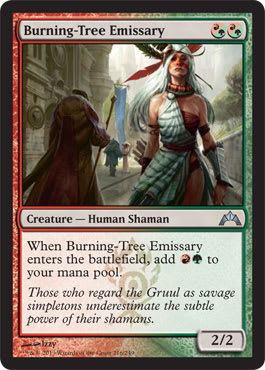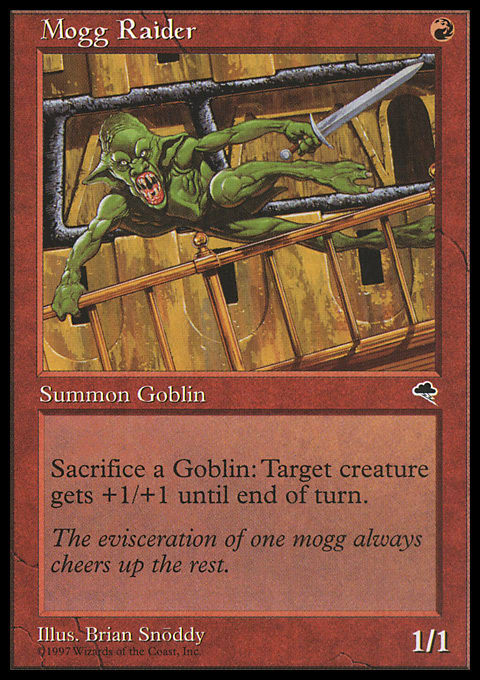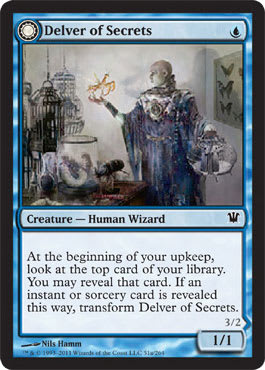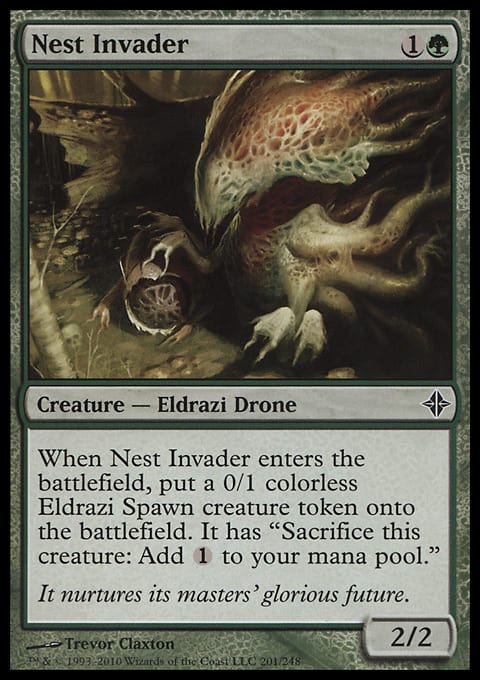Burning-Tree Emissary is here and it has changed everything. The addition of the Gatecrash uncommon to the format has, at least for the time being, pushed Stompy past Delver to assert itself at the top of the heap. This is no small feat, as Delver has been at the summit for quite some time. Burning-Tree Emissary managed to change the texture of the format from a tempo perspective and everything has shifted as a result.
I will be using Tempo to discuss the general pace of the game. Let’s be real for a second: many better players and writers than I have attempted to tackle the subject with middling results so I do not think I am going to nail the definition this go around. To me (and my understanding), Tempo looks at the game in relation to a state of equilibrium. Anything that shifts the on board balance in one direction can be said to affect the Tempo of a matchup (and it is something you want in your favor). Reid Duke did an excellent write up of the subject during his run on Level One at the Mothership and I highly recommend you check that out (as well as everything else he has authored).
With that out of the way we can talk about this balancing act as it relates to Pauper. When the format was first sanctioned the top deck was Mono-Black Control. In a world filled with aggressive decks the one that could cast Crypt Rats and Tendrils of Corruption was at its best. Early Mono-Black Control wanted to negate any early board presence with removal while padding a life total with Tendrils. Eventually the control deck would have enough Swamps on the battlefield to cast a lethal Corrupt. While Crypt Rats could handle multiple creatures it was Tendrils of Corruption that made Mono-Black the deck of its day. The ability to undo an investment while also negating multiple attacks and then untap into a creature and removal made Tendrils a backbreaker. It stayed at the top until Tempest came online.
Mogg Raider changed the math. While Goblin Sledder already existed, the Raider gave Goblins a redundant effect. The key to knocking Mono-Black of its pedestal was to reduce the efficacy of Tendrils and that is exactly what this duo accomplished. Sacrificing the target of the four-mana Instant would turn off the life gain element. Suddenly the opportunity cost of having multiple expensive removal spell was too high and Pauper shifted. Goblins took over thanks to this interaction but also its ability to flood the board with Mogg War Marshal and win from nowhere thanks to Goblin Bushwhacker.
I bring this up because this was the last time there was a dramatic tempo shift at the top tier of Pauper. The relegation of Tendrils of Corruption to the second tier of removal had massive repercussions. It became easier to decks that relied on smaller creatures to compete. Cards like Guardian of the Guildpact were rendered too slow to matter and the curve continued to drop. This benefitted slower decks as well as now a Black-based control deck could cast Phyrexian Rager and a removal spell on turn four instead of just Tendrils. Instead these control decks forestalled their recoup method to the later turns leaving a gap in the developing stages of the game.
In this scrum stepped Delver. The deck was uniquely positioned to take advantage of the format’s low mana curve thanks to Spellstutter Sprite. In the early days this was supplemented by Cloud of Faeries to present a lockdown opening sequence — Delver of Secrets into Cloud with Spellstutter back up — but even with Cloud of Faeries banned Spellstutter Sprite remained a mammoth tempo play.
Aside from the era of Peregrine Drake, Delver has remained the baseline deck in Pauper. It is the yardstick against which every other deck has been measured for years. It runs plenty of powerful cards including Delver of Secrets, Spire Golem, Counterspell, Gush, and the Ponder-Preordain duo. Yet if I had to name one card that was key to the deck’s sustained success it would be Spellstutter Sprite due to the Faerie’s ability to dictate the pace of play. Presenting a threat, no matter how small, while also shutting down a spell, represents a huge swing. Using Sprite as a baseline Delver would seek to control the tempo of a game. Insectile Aberration would apply pressure while Vapor Snag, Snap, and Counterspell would be used to maintain an advantageous board state. But Burning-Tree Emissary has changed this dynamic in a meaningful way.
I often talk about inertia and momentum when it comes to new cards entering Pauper. Given the weight of existing cards — the inertia — a new option has to be sufficiently powerful to make an impact. Over time these cards create a snowball effect — the momentum — that can propel a deck to another level. Stompy has consistently been gaining cards over the years and already had a strong Delver matchup. Burning-Tree Emissary pushed it over the edge. Where Delver sought to control the path of a game the new builds of Stompy want to completely ignore the script and do things its own way.
Stompy ? Pauper | Ichisuka, 5-0 Pauper League
- Creatures (29)
- 1 Silhana Ledgewalker
- 2 Vault Skirge
- 2 Wild Mongrel
- 4 Burning-Tree Emissary
- 4 Nest Invader
- 4 Nettle Sentinel
- 4 Quirion Ranger
- 4 Skarrgan Pit-Skulk
- 4 Young Wolf
- Instants (8)
- 2 Groundswell
- 2 Hunger of the Howlpack
- 4 Vines of Vastwood
- Sorceries (1)
- 1 Epic Confrontation
- Enchantments (4)
- 4 Rancor
- Artifacts (2)
- 2 Bonesplitter
- Lands (16)
- 16 Forest
- Sideboard (15)
- 1 Viridian Longbow
- 2 Epic Confrontation
- 2 Feed the Clan
- 2 Moment's Peace
- 4 Gleeful Sabotage
- 4 Scattershot Archer
This new breed of Stompy is capable of explosive starts. A turn two Emissary can put a Nest Invader on the table or a Green 1-drop next to Vault Skirge, or another Emissary. Much like the Goblins decks of yore sticking a Goblin Sledder on turn one only to follow it up with Mogg War Marshal. Stompy can do this, only instead of 1/1s it makes 2/2s, which is more than twice as good. These draws allow Stompy to ignore the traditional stages of development and accelerate immediately to a dominating position. Access to Quirion Ranger means that these start can work with only one Forest.
Alone this would not be enough for a sea change but the limiting factor on the format, like Tendrils of Corruption before it, has lost some power. Part of Delver’s success is tied to its ability to dictate what sticks on the battlefield after it has cast a Spellstutter Sprite. Burning-Tree Emissary alone may be undone with a Vapor Snag but the bounce does nothing for what the Emissary helped cast. A resolved Burning-Tree Emissary makes it so that Delver will have a hard time keeping parity.
Stompy was already a top tier deck with some hard to beat draws. The addition of Burning-Tree Emissary has pushed it, in my opinion, past Delver. The format has not yet adjusted, in full, to the new baseline deck and we are only scratching the surface of what this means for Pauper. Stompy’s early lead on the leaderboard is to be expected — it is easier to ask questions than have the right answers. Two decks have emerged in an effort to fight the current battle. The first is a deck that emerged at the end of last season but has really picked up steam in after the release of Modern Masters 2017.
Izzet Delver ? Pauper | kungfutress, 5-0 Pauper League
- Creatures (19)
- 3 Augur of Bolas
- 4 Delver of Secrets
- 4 Faerie Miscreant
- 4 Ninja of the Deep Hours
- 4 Spellstutter Sprite
- Instants (17)
- 1 Daze
- 1 Dispel
- 1 Vapor Snag
- 2 Brainstorm
- 2 Skred
- 3 Counterspell
- 3 Gush
- 4 Lightning Bolt
- Lands (18)
- 3 Ash Barrens
- 4 Evolving Wilds
- 2 Snow-Covered Mountain
- 9 Snow-Covered Island
- Sideboard (15)
- 1 Augur of Bolas
- 1 Counterspell
- 1 Swirling Sandstorm
- 2 Skred
- 2 Electrickery
- 2 Gorilla Shaman
- 2 Hydroblast
- 2 Pyroblast
- 2 Stormbound Geist
Izzet Delver operates on a similar principle to the mono-chromatic version. However it is well situated in the current metagame thanks to the presence of Skred and Lightning Bolt. Where Delver would only be able to bounce creatures and see them recast later, Izzet Delver can actually kill the dead. These cards can help the deck maintain parity and attempt to get ahead in the middle and later stages of a game. While the deck has a marginally higher power level it has to make some concessions with its mana base to pull off the Red cards.
Dinrova Tron ? Pauper | RainmakerLuke, 5-0 Pauper League
- Creatures (12)
- 2 Mnemonic Wall
- 3 Dinrova Horror
- 3 Sea Gate Oracle
- 4 Mulldrifter
- Instants (18)
- 1 Pulse of Murasa
- 2 Condescend
- 2 Crop Rotation
- 2 Exclude
- 2 Forbidden Alchemy
- 2 Ghostly Flicker
- 2 Mystical Teachings
- 2 Prohibit
- 3 Moment's Peace
- Artifacts] (7)
- 1 Dimir Signet
- 2 Expedition Map
- 4 Prophetic Prism
- Lands (23)
- 2 Island
- 1 Bojuka Bog
- 1 Remote Isle
- 3 Shimmering Grotto
- 4 Thornwood Falls
- 4 Urza's Mine
- 4 Urza's Power Plant
- 4 Urza's Tower
- Sideboard (15)
- 1 Crop Rotation
- 1 Moment's Peace
- 1 Probe
- 1 Pulse of Murasa
- 1 Radiant Fountain
- 1 Ray of Revelation
- 2 Ancient Grudge
- 2 Electrickery
- 2 Hydroblast
- 3 Dispel
This new take on a control Tron deck is something else. Instead of trying to control the board with removal, Dinrova Tron wants to get to a point where it can cast Moment's Peace every turn until it has enough mana to start using the Ghostly Flicker loop on Dinrova Horror and start eating away at the opposing board. Dinrova Tron is trying to account for Burning-Tree Emissary by fighting on a different axis altogether. The deck only cares about its life total in that it needs it to stay alive before it can assert a dominating position. Moment's Peace is one of the best ways to preserve life points and Crop Rotation can help ensure the deck reaches the full UrzaTron in short order. The combination of Mystical Teachings and Forbidden Alchemy stitch the combo together. All in all the deck is well situated to take advantage of Burning-Tree Emissary builds of Stompy but might falter if Red decks pick up the new common.
Burning-Tree Emissary is an incredibly powerful card and it has pushed Stompy to the top of the heap. Pauper is just now starting to adjust to its new overlord; but, if Izzet Delver and Dinrova Tron are any indication, we are in for some interesting decks in the coming weeks. And Amonkhet is coming fast.


























